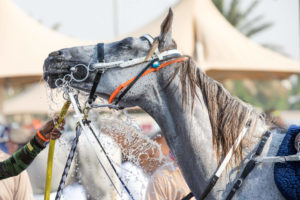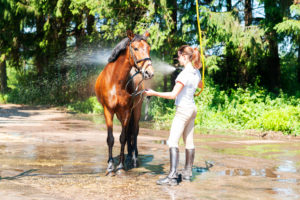 Long hair, too much fat insulation, and hot trailers are a few of the many reasons why a horse could overheat. In hot, humid conditions, the air is damp, and horses’ sweat won’t evaporate. This means the horse stays wet with sweat, but doesn’t get any cooler. It is incredibly important to take preventative measures, as severe cases of heatstroke can lead to collapse or seizures. With summer heat waves, the signs of dehydration and overheating are important for all horse owners to be mindful of.
Long hair, too much fat insulation, and hot trailers are a few of the many reasons why a horse could overheat. In hot, humid conditions, the air is damp, and horses’ sweat won’t evaporate. This means the horse stays wet with sweat, but doesn’t get any cooler. It is incredibly important to take preventative measures, as severe cases of heatstroke can lead to collapse or seizures. With summer heat waves, the signs of dehydration and overheating are important for all horse owners to be mindful of.
If you’re hot, your horse is hotter!
- Horses overheat 10 times faster than humans. In hot and humid conditions, it only takes about 17 minutes of moderate-intensity exercise for your horse to overheat.Working horse muscles can reach temperatures of nearly 110°F. This is the temperature at which muscle proteins begin to cook.
- Only 25%-30% of the sweat your horse produces is effective in cooling them as opposed to 50% in humans. Rehydration and electrolyte replenishment is essential.
- Use the following Temperature + Humidity equation to determine your horse’s schedule. If you add the temperature to the humidity, you will be able to tell if it’s too hot outside for your horse. If the total index is 130 or more, there is serious risk of overheating your horse.
Temperature + Humidity Equation Index:
- 70°F + 35% humidity = 105. This is characterized as “pleasant sporting conditions.”
- 80°F + 50% Humidity= 130. Below 130 your horse can cool themselves properly assuming adequate hydration.
- An index of 130-170= CAUTION! Your horse’s ability to cool themselves is only partially functioning.
- An index of 170 or above= STOP. Your horse’s ability to cool themselves is seriously inhibited. Extra cooling procedures should be used.
- 95°F + 85% humidity = 180. This heat index is a dangerous condition for physical exertion.

It can be incredibly serious if a horse’s body temperature raises from the normal 100° to 105°.
Signs of Dehydration:
MOUTH
- If the mouth and gums that are dry, brick red, or very pale. The mucous membranes should be a healthy, pink color.
- If your horse has poor capillary refill time. Press your finger into his gum and remove. If the spot stays white and pale for a few seconds, meaning the blood doesn’t rush right back afterward, your horse is dehydrated. 3 seconds is too long.
EYES
- A horse’s eyes seem to sink into their head as a sign of fluid loss. Their tissues around the eyes may appear to be wrinkled. Horses and mules exhibiting theses symptoms should be rested, watered, and cooled.
SKIN
- Similar to our skin’s signs of dehydration, it is important to check for a loss of skin elasticity. If a pinch of skin pulled out from the equine’s neck or shoulder stays tented for several seconds, they might be dehydrated. If it takes 2 or 3 seconds, the horse is moderately dehydrated, if it stays elevated for 6 to 10 seconds, he is severely dehydrated.
- Also, their sweat might also become thick and sticky.
BODY
- Although a horse should breathe more rapidly right after exercise, rapid breathing that continues after a few minutes — especially without any sign of slowing down — could indicate that there is a problem.
- Check their temperature. 102°F after an exercise cool-down might warrant a call to your veterinarian. You should know your horse’s normal temperature, heart, and respiratory rates. To find the heart rate of a horse, simply find a pulse and count the beats for 15 seconds, then multiply that number by four, which will give the beats per minute. Count the breaths per minute in a similar way.
- It is important to take precautions if their pulse is elevated, weak, and irregular despite rest.
- The horse’s heart rate also increases as the its body tries to get more blood to the surface for cooling but has less body fluid to accomplish this.

If you suspect your horse is suffering from heatstroke, immediately take measures to help cool him. Contact your veterinarian if symptoms persist or his condition worsens.
To help cool your horse, use all parts of the Springtime’s SOFEB solution:
- Shade: Get your horse out of direct sunlight and into the shade
- Offer water: Allow your horse to drink as much water as desired (not ice cold! 68°F).
- Fan horse: Stand your horse beneath a stable fan or in a breezy area
- End activity: Immediately stop the workout, ride, or farm work
- Bathe immediately: Douse the horse with cold water or a water/alcohol mix
The best way to lower the temperature of your horse is to rinse them in water that is slightly cooler than room temperature, scrape off excess water, and repeat. This can lower their temperature by 2 degrees every 10 minutes! Frequent misting is far more effective than a single dousing with a hose.
Horses can sweat up to 15-20 liters per hour in cool, dry conditions and up to 30 liters in hot, humid conditions. The salt in a horse’s sweat is 4 times more concentrated than humans, so they lose more electrolytes when they sweat. Horses need to replenish them. Cool water, shade, and a fan are great go-to tools to prevent your horse from dehydration and other heat conditions.
 Another resource to add to the list, is a supplement with electrolytes for hydration and replenishment properties.
Another resource to add to the list, is a supplement with electrolytes for hydration and replenishment properties.
Horses and riders: stay safe, and stay cool!


